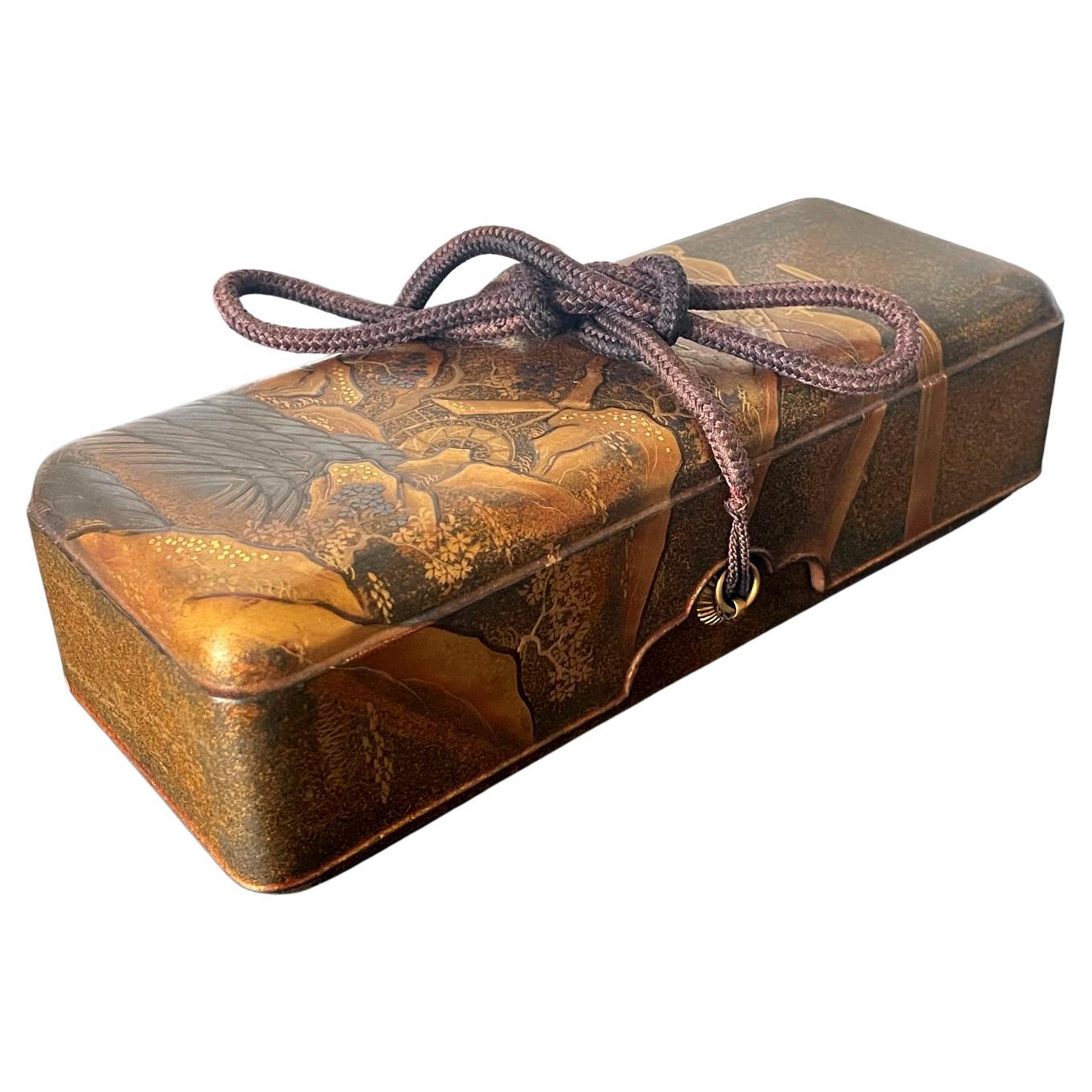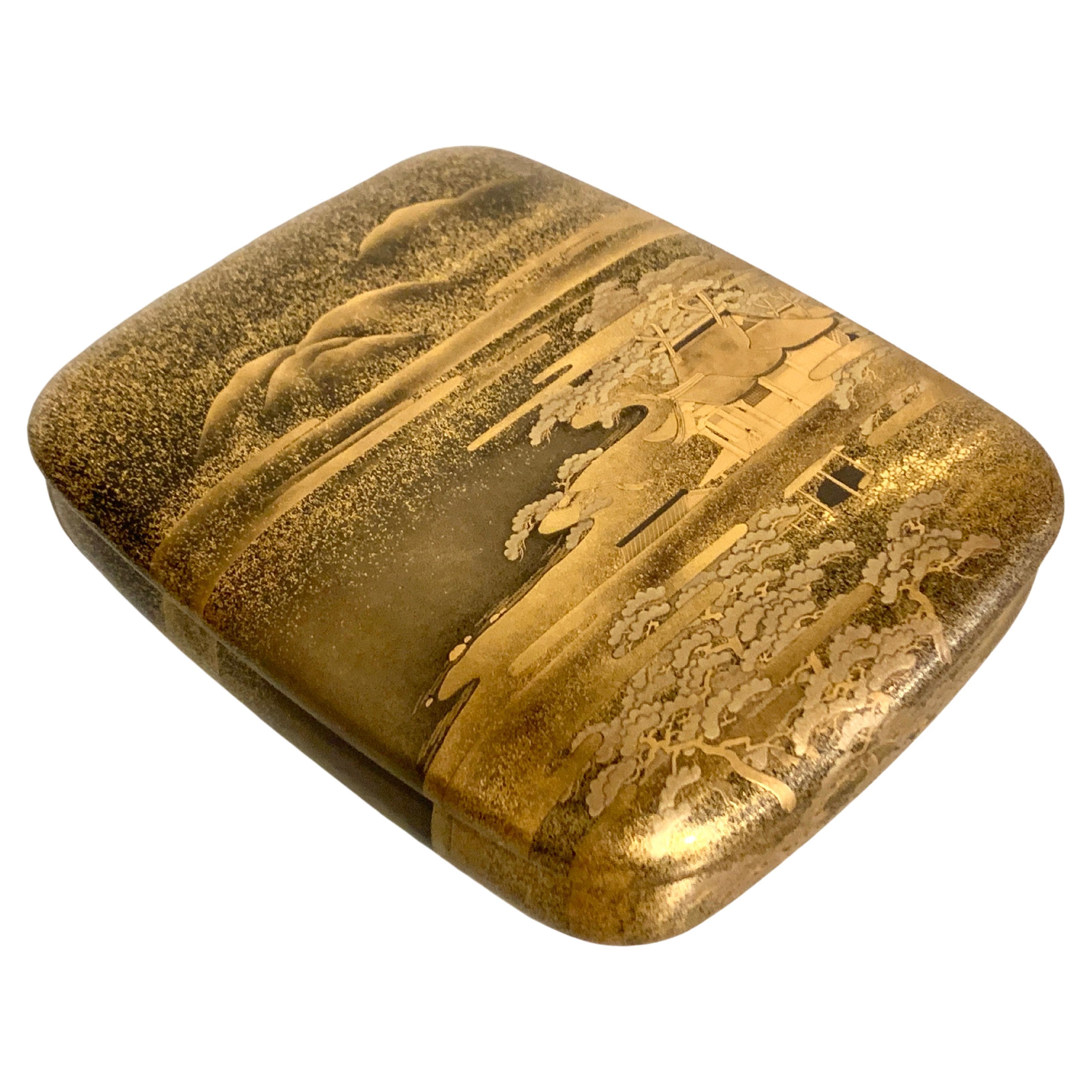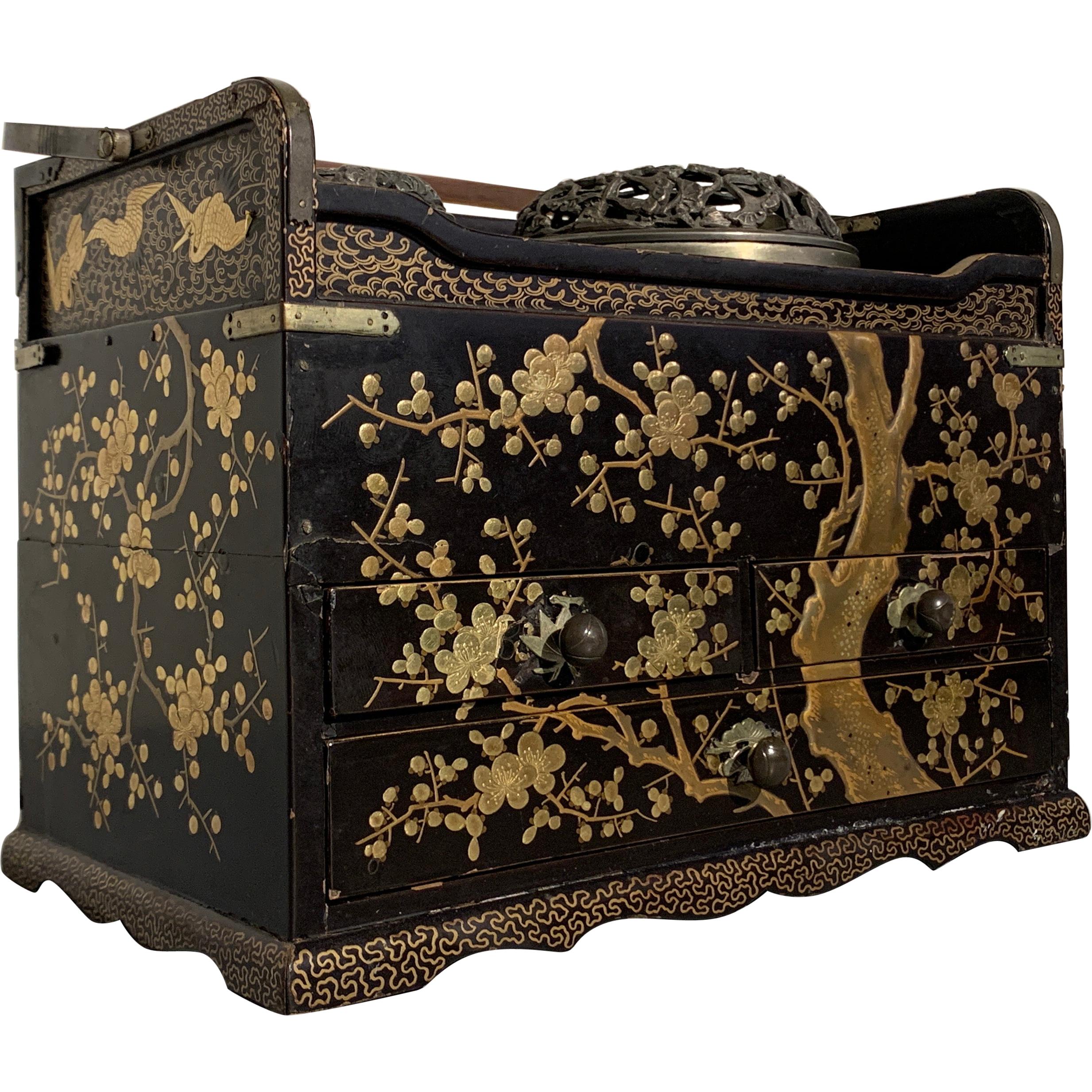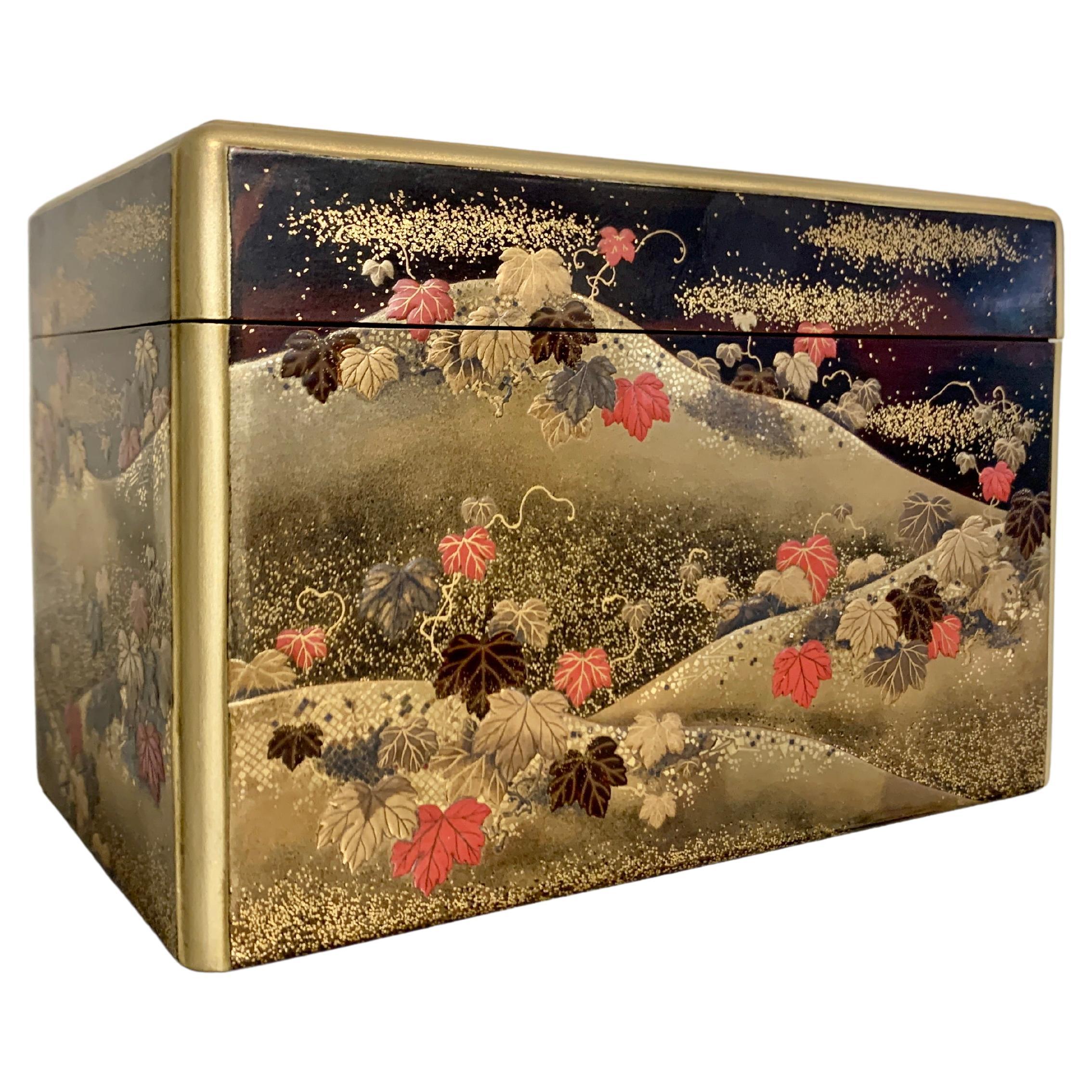Items Similar to Japanese Maki-e Lacquer Document Box, Edo Period, early 19th Century, Japan
Want more images or videos?
Request additional images or videos from the seller
1 of 20
Japanese Maki-e Lacquer Document Box, Edo Period, early 19th Century, Japan
About the Item
A spectacular Japanese maki-e lacquer lidded box, possibly a writing box, suzuribako, decorated with images of folding fans, ogi, Edo Period, early 19th century, Japan.
The low, rectangular box with rounded corners, sumptuously decorated in maki-e lacquer in various techniques, including takamaki-e, hiramaki-e, and nashiji, with small carved coral embellishments.
The exterior of the box boldly and richly decorated with opened folding fans, ogi, designed with attractive landscape and garden scenes in raised lacquer, takamaki-e. Two fans feature idyllic village and temple landscapes. One fan features traditional stone lanterns with willow and a bridge in a garden setting. The other four fans with various trees, including one featuring carved coral cherry blossoms. All against a nashiji ground.
The interior of the lid is perhaps the most impressive, featuring a luxurious palace or temple complex nestled in a mountain setting. The buildings all featuring elegant hip and gabled roofs. The large tree in the foreground embellished with further carved coral blossoms.
The interior of the box more simply decorated with a lone pine tree on a gentle slope against an expansive background of nashiji.
With a typed collection note tentatively identifying the box as a suzuribako, and stating that the piece was purchased from Mark Walberg Fine Art and Antiques at the 2014 edition of The Asia Art Fair, New York.
The underside decorated with nashiji.
Provenance:
Bonhams, NY
Paul and Helen Anbider
Mark Walberg Fine Art and Antiques
- Dimensions:Height: 2.5 in (6.35 cm)Width: 9 in (22.86 cm)Depth: 10 in (25.4 cm)
- Style:Edo (Of the Period)
- Materials and Techniques:
- Place of Origin:
- Period:
- Date of Manufacture:circa 1820
- Condition:Wear consistent with age and use. In very good condition, with minimal wear. The lacquer with a warm patina.
- Seller Location:Austin, TX
- Reference Number:1stDibs: LU894734530172
About the Seller
5.0
Gold Seller
These expertly vetted sellers are highly rated and consistently exceed customer expectations.
Established in 2001
1stDibs seller since 2010
305 sales on 1stDibs
Typical response time: 1 hour
- ShippingRetrieving quote...Ships From: Austin, TX
- Return PolicyA return for this item may be initiated within 7 days of delivery.
More From This SellerView All
- Japanese Lacquer Stationery Box, Suzuribako, Edo Period, 19th c, JapanLocated in Austin, TXA fine and elegant Japanese lacquer box for writing implements or stationery, suzuribako, with an image of a Shinto shrine, Edo Period, mid-19th century, circa 1840, Japan. The exqu...Category
Antique Mid-19th Century Japanese Edo Lacquer
MaterialsGold Leaf
- Japanese Lacquer Smoking Box, Tabako Bon, Edo Period, 19th CenturyLocated in Austin, TXA very fine Japanese maki-e lacquer decorated tabako bon, or smoking box, late Edo Period, mid-19th century, Japan. The elegant smoking box of black lacquer decorated with a wonderful gold lacquer takamaki-e design of a gnarled and elegantly twisted plum tree with branches in full bloom. A border of golden cranes in flight to the top. The smoking box, called a tabako bon, is comprised of an open section at the top with inset with two cylindrical metal canisters...Category
Antique Mid-19th Century Japanese Edo Lacquer
MaterialsLacquer
- Japanese Lacquer Box, Kobako, "The Ivy Way", Edo Period, 19th Century, JapanLocated in Austin, TXAn exquisite Japanese tall lacquer box for incense implements, kobako, with a scene from The Tales of Ise, chapter 9, "The Ivy Way Through Mt. Utsu", Edo ...Category
Antique Mid-19th Century Japanese Edo Lacquer
MaterialsLacquer
- Japanese Lacquer Incense Burner, Koro, Edo period, mid 19th century, JapanLocated in Austin, TXAn elegant and refined Japanese lacquer koro, incense burner, in the form of a chaire, tea caddy, Edo Perio, mid 19th century, Japan. The barrel shaped koro formed as a traditional ...Category
Antique Mid-19th Century Japanese Edo Lacquer
MaterialsCopper
- Japanese Lacquer Writing Box, Suzuribako, Edo Period, 18th Century, JapanLocated in Austin, TXAn exceptionally fine and unusual Japanese lacquer writing implements box, suzuribako, in the form of a zither, koto, Edo Period, 18th century, Japan. With a modern wood storage box,...Category
Antique 18th Century Japanese Edo Lacquer
MaterialsGold, Silver, Copper
- Large Japanese Lacquer Document Box, Ryoshibako, Edo/Meiji period, JapanLocated in Austin, TXA large and magnificently decorated Japanese lacquer document box, ryoshibako, signed Umeboshi/Baikyo, late Edo or early Meiji Period, mid 19th century, Japan. The large document box, ryoshibako, of tall, rectangular shape with rounded corners, and fitted with an inrobuta (flush-fitting) cover with beveled edges. The exterior of this exquisite box is decorated all over with fifteen different raised reserves shaped as uchiwa (paddle) fans against a lush and intricate krikane ground imitating shagreen. The uchiwa shaped reserves all of takamaki-e, and exquisitely painted with designs of animals, flowers, and landscapes in silver, gold, maki-e, hiramaki-e, and takamaki-e, with kirikane, nashiji, and polychrome embellishments, upon gold lacquer fudame grounds. The interior of the lid is nothing short of spectacular, featuring a large design of a magnificent and beautifully detailed rooster and hen with chicks gathered around a lazy stream. Large stalks of chrysanthemum bloom behind them. All against an ethereal nashiji ground. The cover of the box features five reserves: 1. Three minogame (turtles with long tails), symbolizing longevity 2. "Narihira Crossing the Sumida" from The Tales of Ise...Category
Antique 1860s Japanese Meiji Lacquer
MaterialsSoftwood, Lacquer
You May Also Like
- Japanese Lacquered Maki-e Fubako Edo PeriodLocated in Atlanta, GAA Japanese lacquered wood fubako (a box used to store document or small scroll painting), circa second half of 19th century late Edo period. The rectangular box features an unusually deep lipped lid with slightly rounded corners, a conforming lower box that is almost entirely covered by the lid which has two bronze medallion rings with tasseled...Category
Antique 19th Century Japanese Edo Lacquer
MaterialsWood, Lacquer
- Japanese Lacquer Maki-E Scroll Box Fubako by Kansonsai Edo PeriodLocated in Atlanta, GAA Japanese lacquered wood fubako (a box to store document or small scroll painting) circa late 18th century of Edo period. The rectangular box features a deep lid with rounded corners and recessed mid-edge and a lower box with two bronze medallion rings and tasseled silk ties. The surface of the fubako was elaborately decorated with hiramaki-e and a low takamaki-e on a mottled Mura-nashiji background. The motifs on the lid depict branches of Japanese pine with finely rendered needles on the lower part; on the upper part, it showcases fruited persimmon branches. Two different shades of gold fundame were used to contrast the design and augmented by scattered gold kirigane to highlight some of the leaves. The design continues and cascades down to all sides of the lid as well as the walls of the box. The two bronze medallions appear original to the box and the silk ties show significant fading from the age. This Fine fubako is signed on the lower wall "Kanshosai" in Kanji with a kao mark. All the trims were finished in gold fundame and the interiors a dense nashiji in gold. Kanshosai is the mark of the distinguished lacquer artist Lizuka Toyo I who also signed his work "Toyosai". He was active in the second half of the 18th century during Edo period, employed by Hachisuka Shigeyoshi (1738-1801), daimyo of Awa on Shikoku Island. Although most survived work bearing his marks are inros, he was also known to decorated trays and other larger objects...Category
Antique Late 18th Century Japanese Edo Lacquer
MaterialsWood, Lacquer
- Edo Maki-e Japanese BoxLocated in Brescia, ITJapanese box with lacquer lid finely decorated with Maki-e, dating from the 18th century, mid-Edo period. The box is of special size to preserve important calligraphy. All sides of ...Category
Antique Late 18th Century Japanese Edo Lacquer
MaterialsGold Leaf
- Japanese Black Lacquer Document Box with Gold Maki e Design, Meiji PeriodLocated in Prahran, VictoriaAn antique black lacquer document box with an exquisitely detailed, finely wrought design from The Tale of the Genji depicted in gold maki e across the lid. Internally, the box is de...Category
Early 20th Century Japanese Lacquer
MaterialsWood, Lacquer
- Large Japanese Lacquer Box Early Edo Period Ex-Christie'sLocated in Atlanta, GAA large lacquer Ryoshibako (Paper box in Japanese) finely decorated with Maki-e circa 17th century early Edo period. The box is of an impressive size and was used to store paper documents. Both sides of the lid were elaborately decorated with maki-e and the edge was befitted with lead rim, an early practice before the silver rim became common later. The interior and base were finished in Nashiji. The night scene on top surface of the lid depicts flocks of chidoris flying in formation from a sea shore swaying with reeds under a full moon, using hiramaki-e in both gold and silver. Ribbons of clouds were achieved with different densities of gold powder. The underside, in contrast, shows a crescent moon in takamakie-e above the sea with ferns and reeds. Chidoris, the plovers, are symbolic in Japanese culture as "thousands of blessings" and longevity. The Namichidori, the pattern in which the chidori flies in the nami (wave) represents the eternal love and safety of couples and families. For detailed references on the historical background and the use of chidoris on lacquerware, see the reference below. This very lacquer box was featured for sale as lot 339 in Christie's London Sale Japanese Art...Category
Antique 17th Century Japanese Japonisme Lacquer
MaterialsWood, Lacquer
- Exquisite Japanese Lacquer Maki-e Suzuribako by Koma Kyūhaku Edo PeriodLocated in Atlanta, GAOne of the finest Japanese Maki-e Suzuribakos (ink box) we have on offer, the roiro color box showcases an ambient nocturnal scene in which two shakudo inlaid crows perched on the handrails of a bridge (possible the Uji Bridge...Category
Antique Early 19th Century Japanese Japonisme Lacquer
MaterialsStone, Metal
Recently Viewed
View AllMore Ways To Browse
Japanese Red Lacquer Furniture
Medicine Men
Red Shibayama
Burmese Red Carved Wood Temple Offering Box
Chinese Enamel Smoking Set
Japanese Antique Red Lacquer
Japan Plated Lacquer
Japanese Lacquer Plate
Japanese Lacquer Coffer
What Type Of Medicine Was It Used For
Bento Box Vintage
Japanese Tanzaku
Negoro Tray
Lacquer Hsunok
Suzuki Silver
Tokugawa Wedding Box
African Wand
Hasami Bako





